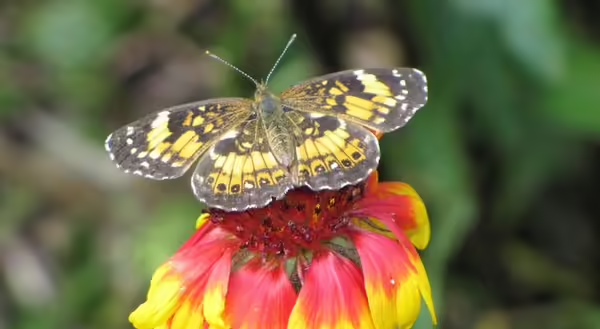
Pollinators are an important part of healthy ecosystems. There are a few easy steps you can take to help support pollinators in your landscape.
Provide diverse nectar and pollen resources
Native plants are a good source of nectar and pollen that pollinators require. Illinois has a wide variety of native wildflowers and shrubs that provide food and habitat for native pollinators. Use the Plant Selector tool on Extension’s Illinois Pollinator Website to get started finding the right plant for your space.
Include a diversity of flowering plants that bloom throughout the growing season to provide a continuous food source. To ensure that pollinators have adequate food sources, aim to have three different species of plants blooming in each season. A diversity of color and floral shape helps to support a wide range of pollinators.
Removing invasive non-native plants from your property is an important step to support pollinators as they can outcompete and displace native plants that pollinators rely on.
Reduce pesticide use
Not all insect infestations require chemical treatment. Gardeners can reduce pesticide use by practicing good gardening habits and conducting early scouting. Reducing pesticide use can prevent unintended harm to beneficial insects during an infestation.
It is important to keep plants healthy, as healthy plants are more resistant to pests. Choose vegetable and fruit crops that are resistant to pests. Exclude pests with row covers or other crop protection. Plant flowers and herbs alongside vegetable garden spaces to invite beneficial insects that offer natural pest control.
Provide nesting sites
Create a habitat for native bees by leaving undisturbed areas with bare soil or providing bee boxes. Different species of native bees have various nesting preferences.
Don't clean up your garden too much. Leave some stems and leaves in place over the winter, as they can provide shelter and overwintering sites for pollinators and their larvae.
For instance, the Baltimore butterfly overwinters as a caterpillar in rolled-up leaves near its host plants such as turtlehead, foxglove, and penstemon. Meanwhile, swallowtails overwinter as pupae camouflaged as dried leaves, and viceroy caterpillars build hibernacula by wrapping leaves in silk and attaching them to plant stems.
Leave plant stems and seed heads so that they continue to support life throughout the winter season. Pollinators and beneficial insects find refuge in this dead plant material, with bees hibernating in the stems and certain butterfly species hiding under leaves and debris. By allowing this plant material to remain in the environment, we can provide a sustainable habitat for these insects to thrive in the following year.
Add a water source
Just as humans require water and food to survive, pollinators need water to supplement their food source. Honeybees scour for water to nourish their young and regulate their hives' temperature. Butterflies also need water, seeking out shallow water sources with good places to land. They also use soil or mud to absorb the essential salt and amino acids they need through a process known as puddling.
Reduce lawn areas
Although weed-free grass can be visually appealing, it provides little nourishment to pollinators and usually requires the use of pesticides and constant trimming. Consider integrating flowering plants such as white clover, self-heal, and thyme that can withstand foot traffic and mowing into your turfgrass. Another option is to replace some of your turfgrass with a no-mow lawn mix of sedges.
If you're reluctant to abandon your lawn, change your mowing habits by raising your mower deck to no lower than four inches. This technique enhances turfgrass health and reduces the need for additional maintenance.
Despite being classified as weeds, dandelions and violets play an important role in supporting the pollination of summer fruits and vegetables. These plants offer valuable sources of nectar and pollen, making them a crucial part of the ecosystem. Bees are attracted to the deep purple hue of violets, which keeps them warm while gathering nectar and pollen on chilly days. Mason bees, small butterflies, and pollinating flies are common visitors to violets, while fritillary butterfly larvae rely on them as a primary source of food. In addition, some small mammals and birds find the seeds of violets to be a tasty treat. Although dandelions provide less nutritious pollen for bees, sulphur, admiral, and comma butterflies are known to enjoy their blooms. Dandelion flowers, buds, and seeds are also consumed by many birds, and hummingbirds use the seeds to construct their nests.
Reduce light pollution
Outdoor lights have a detrimental effect on nocturnal pollinators like moths and beneficial insects such as beetles and true bugs. Artificial lights can confuse these insects and lure them away from flowers, interrupting their natural cycle. This can lead to exhaustion from flying around the lights or being consumed by predators, with up to a third of these confused insects dying by morning.
You can reduce this impact in a few simple steps. Turn off outdoor lights at night or install motion detectors to limit the amount of time the light is on. Yellow L.E.D. bulbs minimize the impact of night light on pollinators, beneficial insects, and migrating birds. Directing light downwards also helps to minimize the impact of light on night flying insects and birds. By taking these measures, you can help protect nocturnal pollinators and maintain the balance of local ecosystems.
Taking a few simple steps can create a space where native pollinators can thrive. Learn more about Illinois Pollinators and how to support them at go.illinois.edu/IllinoisPollinators or contact your local extension office for more information.
Photo by Illinois Extension Master Naturalist Cindy Intravartolo